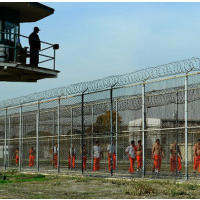Dangerous Inmates Kept in Jail Longer, Prison Populations Cut by 9% in California Counties
 California Corrections officer watches over inmates (photo: Kevork Djansezian, AFP/Getty Images)
California Corrections officer watches over inmates (photo: Kevork Djansezian, AFP/Getty Images)
By Bob Egelko, New York Times
SAN FRANCISCO -- A November 2014 ballot measure that reduced punishment for drug possession and low-level theft crimes lowered county jail populations by 9 percent in its first year, an effect that could increase public safety by allowing more serious criminals to be kept behind bars longer, according to a study (pdf) released Wednesday.
The report by the Public Policy Institute of California gives supporters of Proposition 47 a counterargument against police and prosecutors who blamed the ballot measure for a statewide increase in crime last year. Another study earlier this month found an 8 percent increase in crimes reported in the state's largest cities during the first six months of 2015, compared with the same period in 2014, but also found that crime rates had risen more rapidly in counties that released fewer inmates from jail under Prop. 47.
The new study did not address that question, but said Prop. 47 has eased conditions in counties with overcrowded jails, including Los Angeles, Fresno, Kern and Sacramento, which had been ordered by courts to release inmates early.
``For counties with court orders to cap their jail populations, Prop. 47 created flexibility, allowing jail space to be reallocated toward more serious offenders who might otherwise have been released,'' said Melinda Bird, a co-author of the study.
The initiative, approved by 60 percent of the voters, reduced most drug possession charges from felonies to misdemeanors, punishable by up to a year in jail. It also eliminated felony penalties for shoplifting, check forgery and other nonviolent thefts in which the loss was less than $950, up from a previous limit of $450. Inmates already serving time for those crimes could seek reductions in their sentences.
County jail populations in California had been increasing since 2011 under the state's ``realignment'' law, which sent low-level felons to jail to relieve overcrowding in state prisons. But the new report -- based on figures from a sampling of 13 counties, including San Francisco, Alameda, Contra Costa and Monterey -- said Prop. 47 had reversed that trend in jail populations.
Jail populations in those counties declined by 9 percent, or a total of 4,767 inmates, between October 2014 and October 2015, the report said. It said the number of inmates in custody plummeted by 50 percent for the drug and theft crimes covered by Prop. 47.
Because the charges are now misdemeanors, the report said, those who have been arrested are more likely to be cited and released rather than jailed while awaiting court proceedings. The number of people booked into jail for drug possession in the sample counties declined by 68 percent and by 31 percent for theft charges covered by Prop. 47, the report said.
The study also said the number of convictions for Prop. 47 crimes in the counties dropped by 45 percent during the year.
The report did not explain the decline, but opponents of the measure have argued that by removing the threat of felony prosecution, it weakened prosecutors' hands and reduced the incentive for defendants to plead guilty. They also linked Prop. 47's leniency to increases in property crimes, like the 31 percent rise in auto break-ins in San Francisco last year.
San Francisco District Attorney George Gascon, who campaigned for Prop. 47, disputed those criticisms Wednesday. Crime was increasing in San Francisco before the ballot measure passed, he said, and it didn't reduce penalties for auto burglary -- still a felony -- or decriminalize any offenses.
Before Prop. 47, Gascon said, ``people were being released very quickly because there was not enough space in most of the jails in the state,'' and California's rate of crimes by newly released inmates was ``one of the highest in the world.'' He noted that most of the financial savings from reduced incarceration, estimated by the state at hundreds of millions of dollars a year, was earmarked for programs to reduce recidivism.
To Learn More:
Corrections: California has Reversed its Long-Term Incarceration Trend (Public Policy Institute of California) (pdf)
30,000 Fewer in California Prisons, but Crime Did Not Spike (by Ken Broder, AllGov California)
L.A. County Gives Early Snapshot of Prop. 47’s “Profound Impacts” (by Ken Broder, AllGov California)
- Top Stories
- Controversies
- Where is the Money Going?
- California and the Nation
- Appointments and Resignations
- Unusual News
- Latest News
- California Forbids U.S. Immigration Agents from Pretending to be Police
- California Lawmakers Urged to Strip “Self-Dealing” Tax Board of Its Duties
- Big Oil’s Grip on California
- Santa Cruz Police See Homeland Security Betrayal in Use of Gang Roundup as Cover for Immigration Raid
- Oil Companies Face Deadline to Stop Polluting California Groundwater





